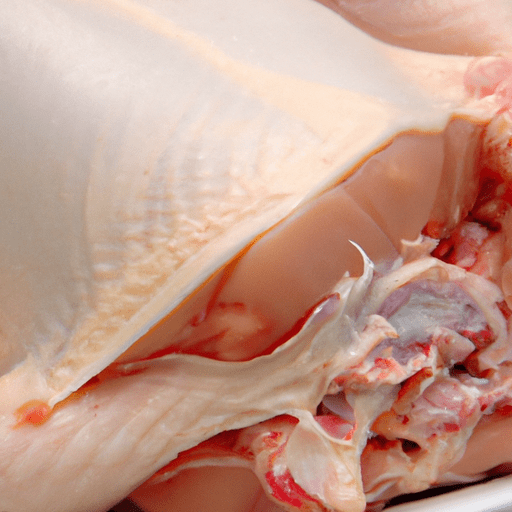Cooking with Bone-In Skinless Turkey Breast: A Delicious and Nutritious Choice
Turkey is a versatile protein that deserves more attention in the kitchen. While the turkey drumsticks and wings tend to steal the spotlight, let’s not overlook the succulent and flavorful bone-in skinless turkey breast. In this blog post, we’ll explore the taste, common uses in cooking, nutritional value, and some interesting history and facts about this delectable cut.
The Taste of Bone-In Skinless Turkey Breast
Bone-in skinless turkey breast is known for its juicy and tender meat. It boasts a mild, savory flavor with subtle hints of sweetness. The bone enhances the flavor during cooking, resulting in a more pronounced and meaty taste compared to boneless cuts.
Common Uses in Cooking
Bone-in skinless turkey breast is incredibly versatile, making it suitable for various cooking methods and recipes. Here are some common uses:
- Roasting: Roasting is a classic and popular way to cook bone-in skinless turkey breast. Seasoned with herbs, spices, and a touch of olive oil, it forms a beautiful golden crust while remaining moist and tender inside. It’s a fantastic centerpiece for holiday gatherings or Sunday family dinners.
- Slow Cooking: Slow cooking bone-in skinless turkey breast allows the flavors to meld together and results in a moist and tender texture. It’s perfect for soups, stews, or chili. The meat easily shreds, making it a wonderful addition to sandwiches or wraps.
- Grilling: Yes, you can grill bone-in skinless turkey breast! Marinate it with your favorite flavors, then grill until cooked through and slightly charred. The smoky flavors from the grill elevate the taste, and the bone keeps the meat even juicier.
- Slicing for Sandwiches: Once cooked, thinly sliced bone-in skinless turkey breast is a fantastic choice for sandwiches. Layer it with some cranberry sauce, lettuce, and herbed mayo for a tasty and satisfying meal.
Nutritional Value and Health Benefits
Bone-in skinless turkey breast is not only scrumptious but also a nutritious choice. Here’s why:
- Lean Protein: It is a rich source of lean protein, which is essential for repairing tissues, maintaining muscle mass, and supporting overall health.
- Low in Fat: Bone-in skinless turkey breast contains significantly less saturated fat compared to other meats, making it heart-friendly.
- High in Vitamins and Minerals: It is packed with essential vitamins and minerals such as vitamin B6, niacin, zinc, and selenium, all of which contribute to a healthy diet.
- Good Source of Tryptophan: Tryptophan, an amino acid found in turkey, promotes healthy sleep patterns and improves mood.
Interesting History and Facts
- Thanksgiving Tradition: Roasted bone-in skinless turkey breast has become synonymous with Thanksgiving feasts in many households.
- Turkey, the Native American Dish: Turkey is native to North America and has been enjoyed by Native American tribes for centuries.
- The Presidential Pardon: Since 1947, the U.S. President has pardoned a live turkey each year as part of the Thanksgiving tradition. These lucky birds are often sent to farms, where they live out the rest of their lives in peace.
In conclusion, bone-in skinless turkey breast is a fantastic choice for cooking enthusiasts looking for a flavorful and nutritious protein option. Whether you roast it, slow-cook it, or grill it to perfection, the results are always delicious. Plus, with its interesting history and versatile uses, it’s a cut of meat worth exploring in your culinary adventures.
Bone-In Skinless Turkey Breast
Origin: Turkey, a large poultry bird native to North America, is believed to have been domesticated more than 2,000 years ago by the indigenous people of Mexico and Central America. Today, turkey is consumed worldwide and has become a popular meat choice, particularly during holiday celebrations.
Common Uses: Bone-in skinless turkey breast is a versatile cut of meat commonly used in various dishes. It can be roasted whole, sliced into cutlets for grilling or sautéing, or diced for soups, stews, and salads. It is often used as a healthier alternative to other meats due to its lean characteristics.
Nutritional Benefits: Bone-in skinless turkey breast is a good source of lean protein, making it an excellent choice for those looking to incorporate more protein into their diet without excessive fat content. It is also low in saturated fat and cholesterol. Additionally, turkey is a source of several vitamins and minerals like niacin, vitamin B6, selenium, and zinc.
Unique Properties and Historical Significance: Turkey has a long-standing association with Thanksgiving, a holiday primarily celebrated in the United States and Canada. The tradition of serving turkey during Thanksgiving dates back to the 17th century, when English settlers in North America adopted the autumn harvest feast practices of the Native Americans. Over time, this custom grew and became deeply ingrained in Thanksgiving celebrations.
Bone-in skinless turkey breast is unique in that it provides a balance between flavor and tenderness, thanks to the bone-in aspect while being devoid of skin. The bone adds moisture and enhances flavor during cooking, while the removal of the skin reduces the fat content.
Overall, bone-in skinless turkey breast offers a healthier protein option with multiple culinary possibilities, from roasting to grilling or even as an ingredient in various recipes.




Use the share button below if you liked it.
It makes me smile, when I see it.